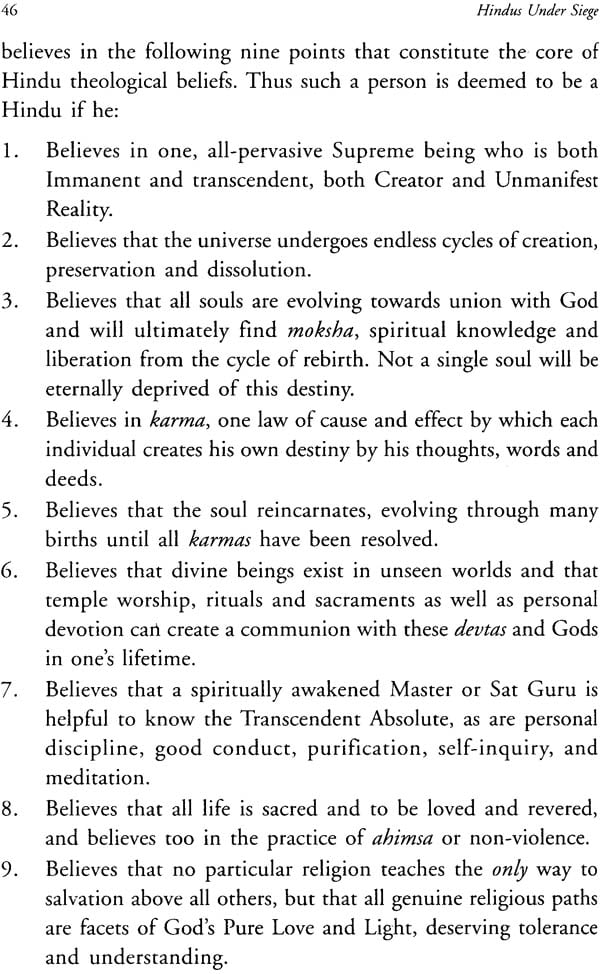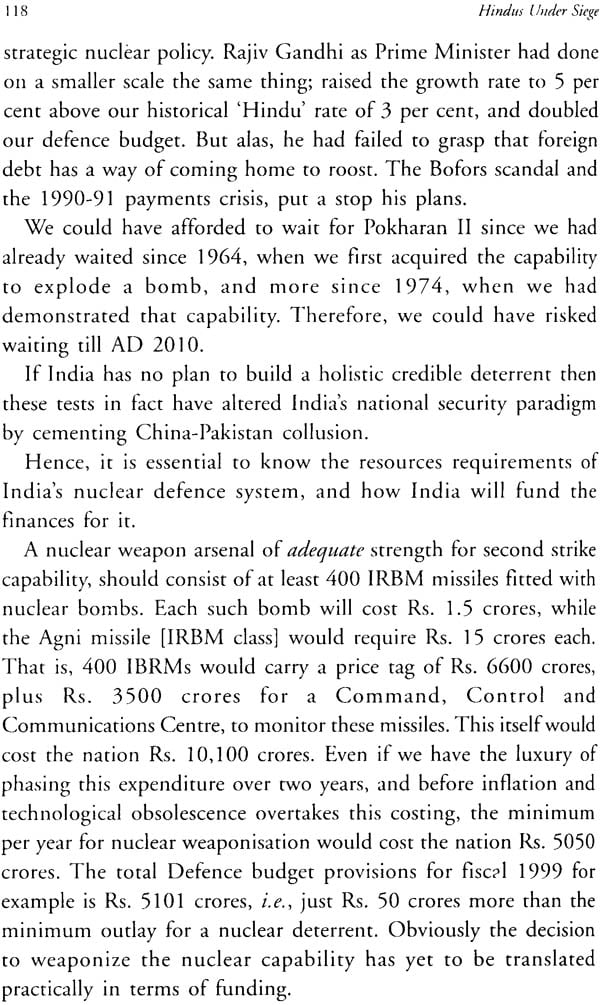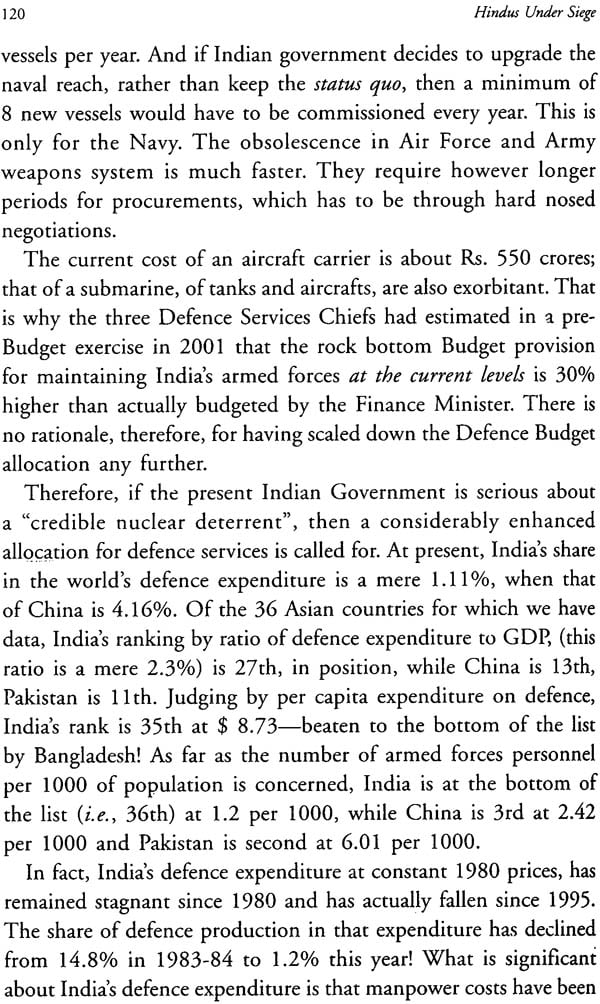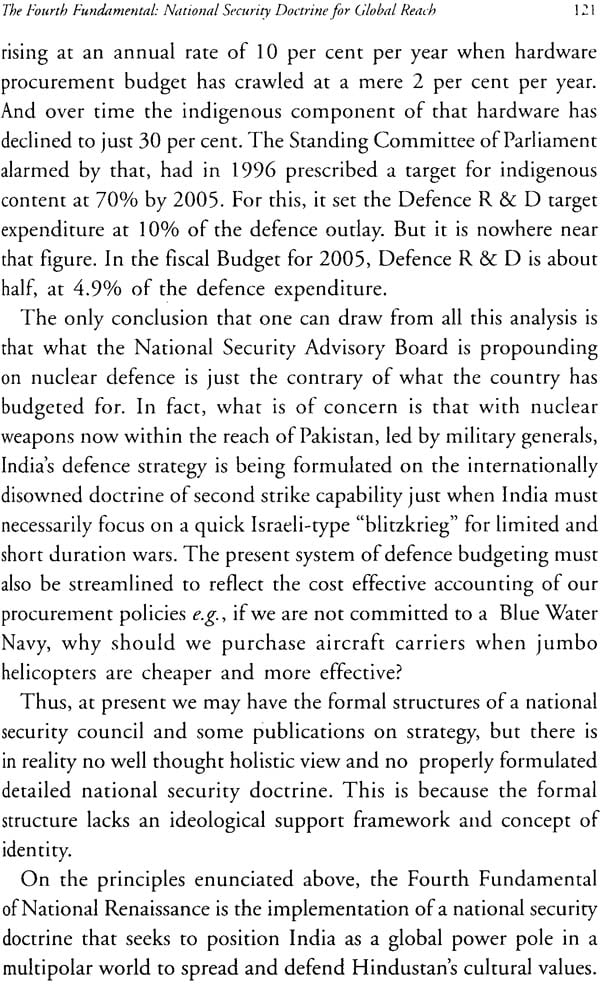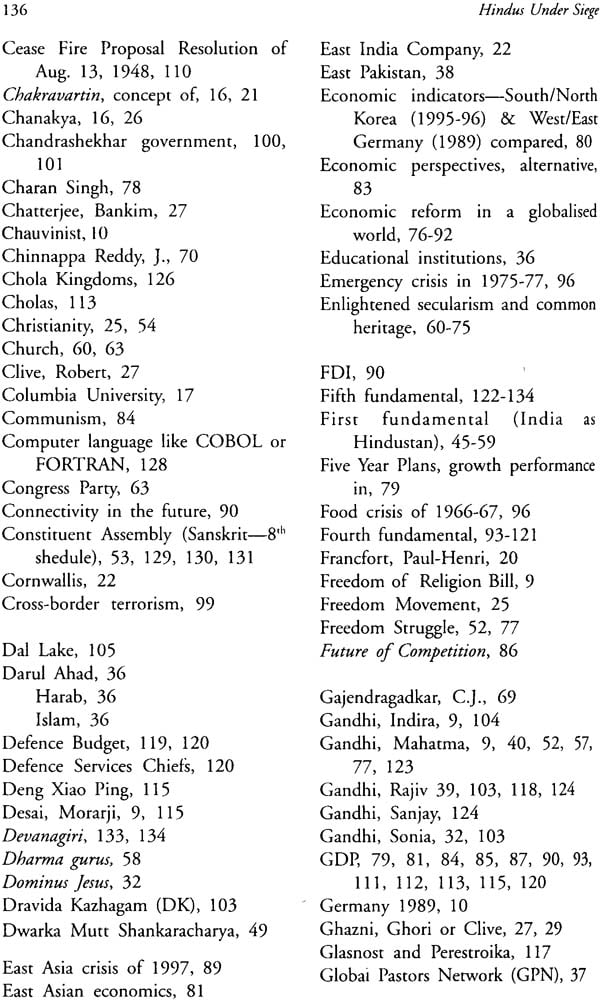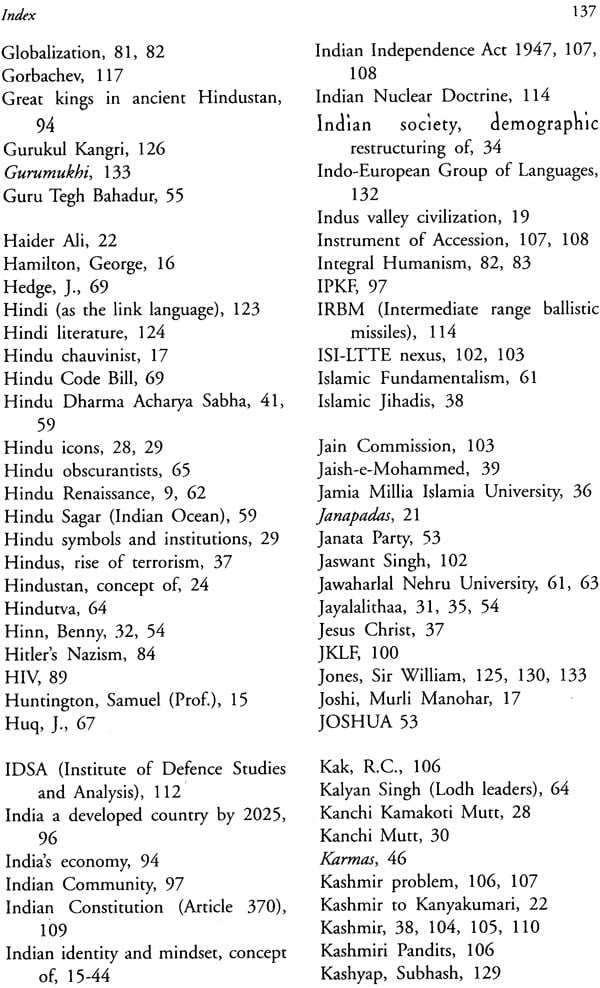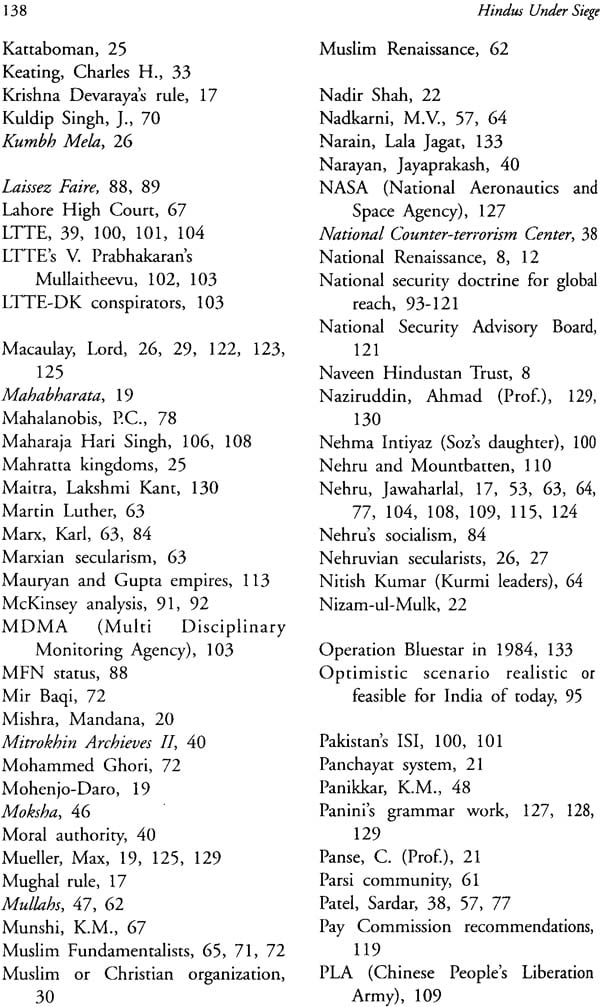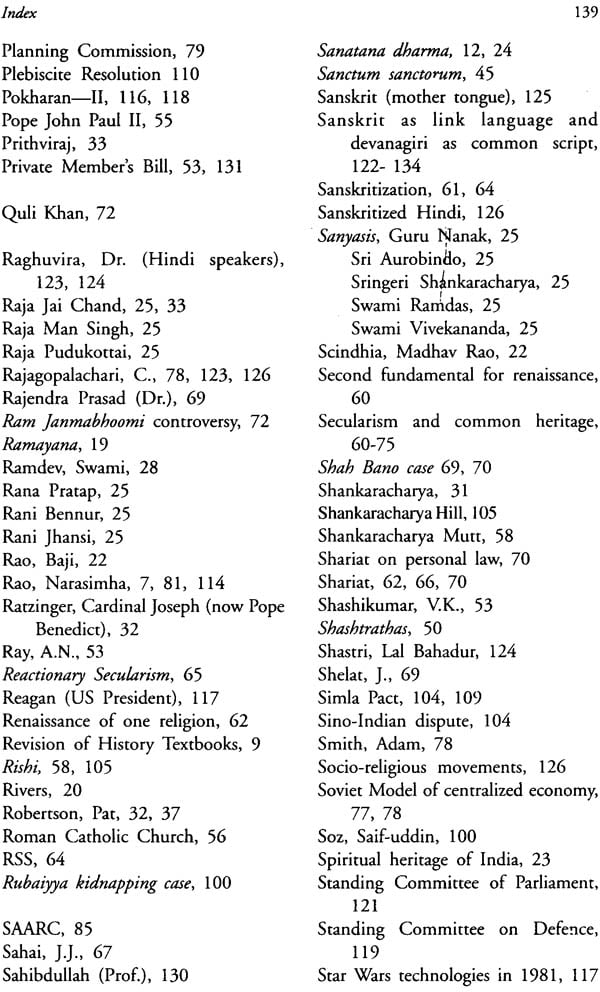
Hindus Under Siege : The Way Out
Book Specification
| Item Code: | NAE941 |
| Author: | Subramanian Swamy |
| Publisher: | Har Anand Publications Pvt. Ltd. |
| Language: | English |
| Edition: | 2015 |
| ISBN: | 9788124112076 |
| Pages: | 140 |
| Cover: | Hardcover |
| Other Details | 9.0 inch X 6.0 inch |
| Weight | 340 gm |
Book Description
The author argues that today, as never before, Hinduism is under an invisible muti-dimensional siege; and that the manifestation of this siege can be seen by those alerted to it. The author suggests that the siege against Hinduism today is visible in four dimentsions:
1. Religious, in the denigration of Hindu icons; 2. Psychological- e.g. in the foisting of a fraudulent versions of our history; 3. Physical - e.g. the Islamic terrorist-driven ethic cleaning of Hindu in Kashmir and Bangladesh, and the money-induced conversion of Hindu to Christianity; 4. Cultural – e.g. through globalisation of tastes, dress and interpersonal morality that are determined in the Anglo-saxon white Christian world (“The West”). The author argues that Hindu must collectively acquire a new mindset, to meet the growing challenge from a highly multi-dimensional siege which is international in character- otherwise over the coming millennium, Hindu run the risk of perishing like the ancient Greeks, Egyptians or Babyonians.
Born in Chennai, Tamil Nadu, India, Dr. Subramanian Swamy has won many laurels. He has contribute to India’s growth in his various capabilities as Member of Parliament, and Cabinet Minister-first as Minister for Commerce, Law and Justice (1990-1991) and later as Chairman of the Commission on International Trade and WTO’s labour standards (1994-1996).
His doctorate in economics from Harvard University was followed by his research projects with Simon Kuznets and Paul Samuelson and his joint authorship with Prof. Samuelson on a path breaking study on Index Number Theory.
He continues to be a visiting faculty member at Harvard University. A man who has fought fearlessly for his convictions, the causes he has espoused include his heroic struggle against Emergency in India, his efforts towards opening of the Kailash-Manasarovar pilgrim route in relationship with China, India’s recognition of lsrael, economic reforms and Hindu Renaissance.
In 1971, after a decade of scholarship and teaching economics at Harvard University, I returned to India and published a best-seller Indian Economic Planning-An Alternative Approach. In public platforms thereafter, I began propagating an alternative economic strategy for India that called for adopting a market economy strategy for India that called for adopting a market economy, for restructuring our foreign policy to befriend the US, Israel and China and thus diluting our dependence of USSR. That ideological package was heavily condemned then by Left-dominated academia. But the unravelling of the USSR and the adoption of pro-market reforms by communist China has now completely undermined the Left intellectual position. My views have, therefore, become mainstream.
Since becoming free of British Imperialist rule in 1947, India’s ideological space had been for five decades circumscribed by a in the mainstream of thought for any other significantly different ideological perspective. Because of a dominant government controlling the commanding heights of the economy, ruled by a party that became increasingly authoritarian, any serious secular ideological challenge to this established thought was crushed at the nascent stage. Even when the nation faced a grave economic crisis, as in 1991, that required some dismantling of the oppressive regulatory system, it was dressed up as a reform and a natural evolution of the same framework. But the author of this reform who dared to deviate more than necessary, namely, Prime Minister Narasimha Rao, was disowned by his party and the Left, and then was pilloried, defamed and criminally prosecuted till his heart gave out. Even in his last rites, he was not honoured. Instead he was made an example of, for others who doubted this Left-leaning socialist secular framework.
In this suffocating atmosphere, only a right wing religious radical formation could find a footing, and which gradually expanded onto the center stage of the national ideological platform. But within six years of being in power and office, that too fizzled out because of the leadership’s inexplicable reluctance to make a clean and clear break with the past failed ideological framework.
Both the Left-leaning secular Socialist and the Capitulationist Right have had their inning, and are unlikely to regain the center stage. What remains today in the country is an ideological mish-mash. Till a new ideological framework is designed and presented with clarity to the people, the present hybrid ideological ad hocism will continue. This confused state of affairs cannot steer the nation to new heights of economic development, a more cohesive nation, and world power status.
To research, propound, and propagate a new ideological framework that can unite the nation, make the people strive to global greatness and struggle for the world power, the Centre for National Renaissance has been set up in New Delhi to be funded by the Naveen Hindustan Trust. My colleagues and I, who constitute the Centre’s Board of Governors, have an established and acknowledged record of dissenting from the past ideological framework of the nation. This dissent has sometimes taken the form of struggle and for this we have suffered: the state has denied us our due in our professional life. We also were denounced as conservatives of reactionaries. But we never wavered, convinced that the day will dawn when an alternative ideology of national renaissance or modern conservatives will be needed by the Country. The new millennium holds that promise. We need, Therefore, to have a clear understanding of an agenda for renaissance.
At the present juncture of our history, if we are to pick up the thread of renaissance from where it had been snapped in 1947, and from where Swami Vivekananda, Maharishi Aurobindo and Mahatama Gandhi had brought it, we need first to define a new agenda, and then build a suitable vehicle to implement that agenda to its fruition. For that we have to be clear about the fundamentals of Indian identity, and of renaissance itself.
Is there a need for such an agenda? In the absence of a well-articulated and well-thought through agenda, there will always be in circulation, a defunct or a haphazard one. Those who decry the need for an explicit and positive agenda are usually slaves of defunct ones. The Morarji Desai Government had such an unarticulated agenda. It consisted of four points: Prohibition, Ban on Cow-slaughter, Freedom of Religion Bill, and Revision of History Textbook. None of the points of this agenda were in inherently bad, but because the raison d’etre, or the fundamental premise of the agenda was not to raise the consciousness of the people but to pursue it as a law and order matter, the implicit Desai agenda came into disrepute and was then denounced as retrograde by Leftists in India, who are neurotic about any move to usher in anything resembling Hindu renaissance. During her long reign of 16 years, Mrs. Indira Gandhi too was an adherent of an implicit agenda which was a mixture of Mrs. Gandhi’s own noblesse oblige, and superstitious belief in tantrik practices. During Mrs. Gandhi’s reign, the so called God-man astrologers and Yagna performs proliferated, and thus the agenda boiled down to merely fossilizing existing religious practices and caste structures, and to depending superstitious beliefs. During Mrs. Gandhi’s reign we got the worst of both worlds. On the one hand we failed to foster a positive attitude towards our heritage and civilization, and on the other hand we strengthened bodies which inculcated the narrow and obscurantist interpretation of living Hindu wisdom.
The lesson to be drawn from our past experience thus is that either India explicitly will have to adopt an agenda and make dynamic progress, or suffer an implicit defunct agenda, which will invariably be retrograde, and weaken the country. The items on this Agenda will constitute the Indian identity and goals, and will foster the renaissance. No nation can survive for long without a binding identity concept. Why was Akhand Hindustan partitioned in 1947? Or Pakistan split in 1973? Or the USSR disintegrated in 1991? Or Yogoslavia balkanised in 1996? Or alternatively why were Germany [1989] and Vietnam [1975] reunited? A common history, language structures, folklore, and a common perception of the same, of the people, blinds them into a nation. A lack of it divides nations, sooner or later.
What are them the items of such an Agenda which can have national support of patriots and yet usher in a renaissance? How much of this renaissance will be for Hindus, and in how much of it can the minorities participate without feeling insecure or threatened? How can consensus shape clarity in the concept of an Indian identity? These are crucial questions I hope to answer in the chapters of this book. Those opposed to a vibrant patriotic bonding of Indians will, no doubt, find much of what I say as ‘Chauvinist’ and ‘Conservative’ but I own the epithets. Nothing I say will satisfy them because these critics such as communists are ‘guided,’ and even controlled, by foreign ideologies and interests. Others may disagree and want to debate the issues. I welcome these others.
What does it ideologically mean to be a conservative? Conservatives do not promise to create heaven on earth. We know that to be an idle utopia. Instead conservatives promise change while preserving the best in our past. As conservatives we dare to change the things that we must and can, and await the moment when we can change that which we must but which we cannot for now. The wisdom of the ideology lies in delineating possibilities. But we are for consistent, if only gradual, change brought about by the individual himself driven by his own enlightened interests in the milieu of voluntary social actions and norms. We do believe that the individual can be, and should be, motivated by incentives, by equipping him with fundamental concepts of his individual, social and national identity, empowered by adequate education, and a democratic temper.
Since achieving independence from colonial rule in 1947, we Indians have been unsuccessfully grappling with the following question: Who are we? This as – yet unanswered question: represents India’s identity crisis. The failure to date to resolve this crisis, has not only confused the majority but has also confounded the minorities as well in India. Without a resolution of this crisis, the majority will never understand how to relate to the legacy of the nation. In other words, the present dysfunctional perceptional mismatch, between who we are as a people and the legacy of the national, is behind most of the communal tension and intercommunity distrust in the country. Even in other countries such a question arises from time to time. In the United States, following relatively liberal immigration policies since 1965, the question has again arisen. Prof. Samuel Huntington of Harvard has tried to answer this question in his new book: Who We Are?
What is India; and why are we thousands? Is India an ancient nation, a continuing civilization of thousands of years, or is it a relatively recent administrative construct of British imperialist and legalized by the British House of Commons legislation, viz., The Indian Independence Act of 1947? What is the core of India’s ethos; Hindu, Secular or Hindustani? And what dos each mean? Citizens of modern India are of course not sure! That is today’s identity crisis. Unless we answer this question clearly, finally, unambiguously, and authoritatively as to who we are, Indians will flounder, flip-flop, and generally be devoid of healthy patriotism. This is not to suggest that any person’s identity is uni-dimensional. The nature of a person’s questioning mind in a pluralistic democracy identity dimension is an imperative for a nation to become vibrant and dynamic. What we are concerned with here is the lack of a national identity, not how to make such an identity the sole concern. When the nation is in danger, national identity must take precedence. That is what Chanakya meant by the concept of a “Chakravartin”.
The core fundamentals of our national identity, through a correct perception of our history, will help to restructure and reform our society on that basis and will make it cohesive and united. To achieve such a restructure, of course, requires a complete defalsification of Indian history, rejecting that portion that has been deliberately contrived by British imperialists and their Indian compradors, to snap the linkages to our real past.
The present history taught in our schools and colleges is still the British-imperialist sponsored one, in which India as a State is treated as of recent origin and British-created. The Indian people are portrayed as a heterogeneous lot who are hopelessly divided against themselves. Both caste and language difference are given an ethnic interpretation.
Such a “history” had without doubt been British policy. Sir George Hamilton, Secretary of State for India, wrote on March 26, 1888 that “I think the real danger of our rule is not now but say 50 years hence…We shall break Indians into two sections holding widely different views…We should so plan the educational text books that the differences between community and community are further strengthened”. Dr. B.R. Ambedkar challenged this view as far back as 1916, when, as a doctoral students of economics at Columbia University, he wrote a paper for an Anthropology Department seminar as follows: “Ethnically, all people are heterogeneous. It is the unity of culture that is the basis of homogeneity. Taking this for granted, I venture to say that there is no country that can rival the Indian Peninsula with respect to unity. It has not only geographic unity, but it has over and above all a deeper and much more fundamental unity-the indubitable cultural unity that covers the land from end to end.
After achieving independence, under the leadership of Jawaharlal Nehru and the implementing authority of the ICS, defalsification of our history was never done, in fact the very idea was condemned as “obscuranist” and Hindu chauvinist. For a brief period, when Murli Manohar Jos hi was in charge of the Education portfolio at the Centre (1998-2004) and attempt was made to defalsify history. But again it was done not by challenging scholarly debate, but by changing textbooks on government diktat , i.e., putting the ‘cart before the horse’. The effort became tainted as ‘saffronisation’. Joshi had got it right conceptually, but he got poor support from his colleagues in government for implementing it. It was not given priority. What is the gist of this British imperialist-tailored Indian history? In this history, India is portrayed as the land conquered first by the Dravidians, then by the Aryans, later by Muslims, and finally by the British. Our history books today portray this obsession with foreign rule. For example, even though the Mughal rule from Akbar to Aurangzeb is about 150 years, much shorter than the 350 year rule of the Vijayanagaram empire, the history books of today hardly7 take notice of the letter. In fact the terrirtory under Krishna Devaraya’s rule was much larger than Akbar’s, and yet it is the letter who is called “the Great”. Such a version suited the British rules who had sought thereby to create legitimacy for their presence in India. Furthermore, we were also made to see advantages accruing from British rule, the primary one being that India was created by this colonialism; that but for the British, India would never have been a country, that we were freed from superstition and obscurantism by the colonisers and given a ‘modern’ education to boot.
These totally false and pernicious ideas have permeated deep into our educational systems. They have poisoned the minds of our younger generations who have not had benefit of the freedom struggle to awaken their pride and nationalism. It has thus o be an essential part of the renaissance agenda that the two ideas of British-sponsored history of India are discarded, namely: (1) that India as a State was a gift of the British and (2) that there is no such things as a native Indian, and what we are today is a by-product of the rap of the by visiting conquerors and their hordes.
Just because India did not have a nation state of the present boundaries, exercising control through a unified modern administration, does not mean that there was no India. On the contrary, there was always an India, which, from north to south, thought fundamentally as one country. Just as Hinduism exists from thought fundamentally as one country. Just as Hinduism exists from ancient days despite a lack of a ‘Church, Book, or Pope’, Hindustan too existed from time immemorial but without the paraphernalia of the modern state.
The British on the contrary tried to disrupt that unity by destroying the traditional communication channels and structures, and demeaning India’s heritage by falsification and disinformation.
Thus, we need a new factual account of our history, focusing on the continuous and unbroken endeavours of a people united as a nation. This history of India must deal with the conscious effort of our people to achieve a civilization, to reach better standards of life, and live a happier and nobler life. The lamp of faith of the Indian people burned brightly over a long period. We must also record when that faith dimmed in our history and brought shame to the people. Such a factual account of our past is essential to the Agenda, because we have to disgorge and discard the foreign versions of our history with credibility. It is the foreign version that makes us foreigners in our own land. The Aryan-Dravidian divide in the history taught in schools and universities is purely a conception of foreign historians like Max Mueller; and it has no basis in Indian historical records. This fraudulent history has been lapped up by many upper caste Indians, as their racial passport to Europe. Such has been the demoralization of the Hindu mind, which we have to shake off through a new factual account of our past.
| 1 | Introduction: The Concept of an Indian Identity and Mindset | 15 |
| 2 | The First Fundamental: The Concept of India as Hindustan | 45 |
| 3 | The Second Fundamental: Enlightened Secularism and Common Herita | 60 |
| 4 | The Third Fundamental: The Strategy for Economic Refom in a Glonalised World | 76 |
| 5 | The Fourth Fundamantal: National Security Doctrine for Global Reach | 93 |
| 6 | The Fifth Fundamantal: Sanskrit as Link Language and Davanagiri as Common Script | 122 |
| 7 | Index | 135 |

